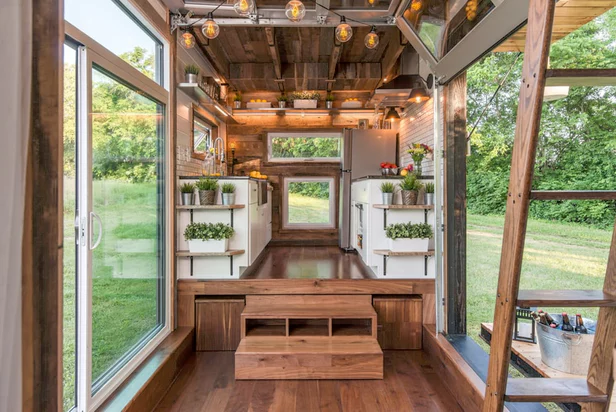Tiny, in a literal sense, means small. Hence, the Tiny House Movement refers to the concept of living in smaller sized homes rather than the more conventional large ones. This is more of an emerging social movement, and the concept was introduced by Jay Shafer in 1997, who built a house on wheels for his personal use. Later, he established the Tumbleweed Tiny House Company to provide building plans and information to the world about the benefits and particulars of these homes.
This company is a globally certified manufacturer and all the workers involved are highly trained and experienced. This movement is very similar to caravanning; where people sell or just give away their extraneous belongings and move into a mobile home. This largely contributes to a simpler and more economical way of living.


Now, coming to the size of a tiny house, a traditional American house is approximately sized around 2,600 square feet, while a regular tiny house is somewhere between 100 to 400 square feet. These houses can either be rented or owned. Options include a house on wheels or a basic house which utilizes a minimal amount of surface area. This all depends on the ease of the person, and on how comfortably he can live in a given space. The shape and form of the house varies as per a person’s requirements. The need of these houses are dependent on variable factors such as affordability, practicality, environmental concerns, and so on.
The major advantage of living in a simpler setup is the cutting down of costs. On average, it takes around 15 years for a regular American to build a house, because of the high costs involved in buying or building a conventional house. The bigger the house is, the more expenses are involved, such as utility bills and maintenance costs.
The concept of smaller houses, however, can make lives simpler. The money which was previously used for building a home, can now be used for a better alternative or saved for the future.
In South Asia, housing sizes vary in size. This depends upon the locality and area where the property is being developed and sold. In one of the developing countries of South Asia, Pakistan, you may find online property portals such as Prop.pk, which can help you choose the property listings that best fit your needs.
The trend of ‘Tiny Houses’ has largely increased over time. Over the past four years, Google Trends have been tracked, and according to the research done by the National Association of Home Builders, this interest increased in millennials by 63%.
This concept is not just confined to the US, but has also spread to countries like New Zealand, the Philippines and Canada etc. This practice is quite suitable for India, as there is rapid population growth in the country. If people start adopting this movement, it can help fulfil the goal of ‘Housing for All’ by 2022. Building smaller houses can help accommodate the large population in India, and alleviate the deprivation faced by the homeless. To find the right housing scheme for you in India, you can use portals such as housing.com.
Popular media is doing its part in promoting this concept, with TV shows such as ‘Tiny House Hunters,’ and ‘Tiny House Builders.’ There is also a movie called ‘Tiny: A story of Living Small’ to shed light on this model.
There are a number of tiny houses that are available; such as Tumbleweed Tiny Houses, which are a product of Tumbleweed Tiny House Company (as mentioned earlier); another one is Tiny Texas Houses, a company which offers relatively smaller homes in the state where ‘everything is bigger’.
Shipping container homes are an extension of this theme, and use metal shipping containers. Instead of sending containers to scrap heaps, they are redesigned and remodeled into prefabricated homes.
In addition to this, tiny luxury homes are tiny, but not necessarily simple, homes. These are priced higher than, but are much more luxurious than regular tiny homes.
Lastly, there are micro-apartments, which offer affordable rental opportunities in big cities and are sufficient for a single person.
So, after we’ve studied in detail of what the tiny house movement is and weighed its pros and cons, we can conclude that these homes are beneficial for budget living. With families getting smaller and society becoming ore individualistic, these homes may eventually become the norm. This is because they are more practical and less of a hassle. Over time, They are more economically friendly, with less maintenance involved and people are becoming more adaptable to the idea of living in them.
This website uses cookies.